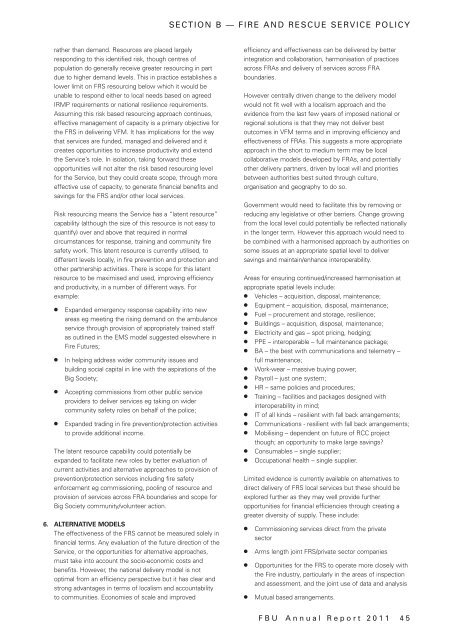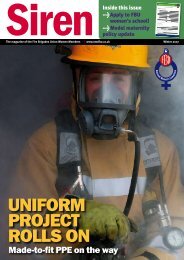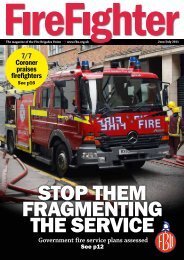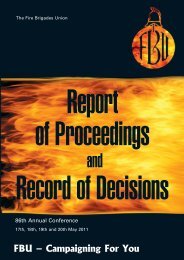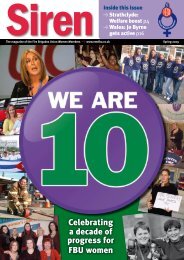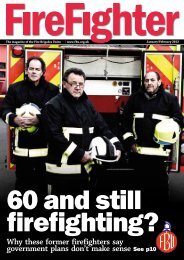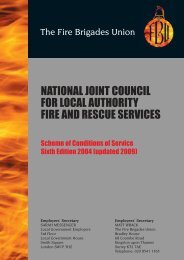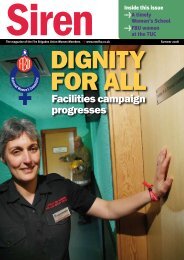Report - Fire Brigades Union
Report - Fire Brigades Union
Report - Fire Brigades Union
You also want an ePaper? Increase the reach of your titles
YUMPU automatically turns print PDFs into web optimized ePapers that Google loves.
SECTION B — FIRE AND RESCUE SERVICE POLICY<br />
rather than demand. Resources are placed largely<br />
responding to this identified risk, though centres of<br />
population do generally receive greater resourcing in part<br />
due to higher demand levels. This in practice establishes a<br />
lower limit on FRS resourcing below which it would be<br />
unable to respond either to local needs based on agreed<br />
IRMP requirements or national resilience requirements.<br />
Assuming this risk based resourcing approach continues,<br />
effective management of capacity is a primary objective for<br />
the FRS in delivering VFM. It has implications for the way<br />
that services are funded, managed and delivered and it<br />
creates opportunities to increase productivity and extend<br />
the Service’s role. In isolation, taking forward these<br />
opportunities will not alter the risk based resourcing level<br />
for the Service, but they could create scope, through more<br />
effective use of capacity, to generate financial benefits and<br />
savings for the FRS and/or other local services.<br />
Risk resourcing means the Service has a “latent resource”<br />
capability (although the size of this resource is not easy to<br />
quantify) over and above that required in normal<br />
circumstances for response, training and community fire<br />
safety work. This latent resource is currently utilised, to<br />
different levels locally, in fire prevention and protection and<br />
other partnership activities. There is scope for this latent<br />
resource to be maximised and used, improving efficiency<br />
and productivity, in a number of different ways. For<br />
example:<br />
●<br />
●<br />
●<br />
●<br />
Expanded emergency response capability into new<br />
areas eg meeting the rising demand on the ambulance<br />
service through provision of appropriately trained staff<br />
as outlined in the EMS model suggested elsewhere in<br />
<strong>Fire</strong> Futures;<br />
In helping address wider community issues and<br />
building social capital in line with the aspirations of the<br />
Big Society;<br />
Accepting commissions from other public service<br />
providers to deliver services eg taking on wider<br />
community safety roles on behalf of the police;<br />
Expanded trading in fire prevention/protection activities<br />
to provide additional income.<br />
The latent resource capability could potentially be<br />
expanded to facilitate new roles by better evaluation of<br />
current activities and alternative approaches to provision of<br />
prevention/protection services including fire safety<br />
enforcement eg commissioning, pooling of resource and<br />
provision of services across FRA boundaries and scope for<br />
Big Society community/volunteer action.<br />
6. ALTERNATIVE MODELS<br />
The effectiveness of the FRS cannot be measured solely in<br />
financial terms. Any evaluation of the future direction of the<br />
Service, or the opportunities for alternative approaches,<br />
must take into account the socio-economic costs and<br />
benefits. However, the national delivery model is not<br />
optimal from an efficiency perspective but it has clear and<br />
strong advantages in terms of localism and accountability<br />
to communities. Economies of scale and improved<br />
efficiency and effectiveness can be delivered by better<br />
integration and collaboration, harmonisation of practices<br />
across FRAs and delivery of services across FRA<br />
boundaries.<br />
However centrally driven change to the delivery model<br />
would not fit well with a localism approach and the<br />
evidence from the last few years of imposed national or<br />
regional solutions is that they may not deliver best<br />
outcomes in VFM terms and in improving efficiency and<br />
effectiveness of FRAs. This suggests a more appropriate<br />
approach in the short to medium term may be local<br />
collaborative models developed by FRAs, and potentially<br />
other delivery partners, driven by local will and priorities<br />
between authorities best suited through culture,<br />
organisation and geography to do so.<br />
Government would need to facilitate this by removing or<br />
reducing any legislative or other barriers. Change growing<br />
from the local level could potentially be reflected nationally<br />
in the longer term. However this approach would need to<br />
be combined with a harmonised approach by authorities on<br />
some issues at an appropriate spatial level to deliver<br />
savings and maintain/enhance interoperability.<br />
Areas for ensuring continued/increased harmonisation at<br />
appropriate spatial levels include:<br />
● Vehicles – acquisition, disposal, maintenance;<br />
● Equipment – acquisition, disposal, maintenance;<br />
● Fuel – procurement and storage, resilience;<br />
● Buildings – acquisition, disposal, maintenance;<br />
● Electricity and gas – spot pricing, hedging;<br />
● PPE – interoperable – full maintenance package;<br />
● BA – the best with communications and telemetry –<br />
full maintenance;<br />
● Work-wear – massive buying power;<br />
● Payroll – just one system;<br />
● HR – same policies and procedures;<br />
● Training – facilities and packages designed with<br />
interoperability in mind;<br />
● IT of all kinds – resilient with fall back arrangements;<br />
● Communications - resilient with fall back arrangements;<br />
● Mobilising – dependent on future of RCC project<br />
though; an opportunity to make large savings?<br />
● Consumables – single supplier;<br />
● Occupational health – single supplier.<br />
Limited evidence is currently available on alternatives to<br />
direct delivery of FRS local services but these should be<br />
explored further as they may well provide further<br />
opportunities for financial efficiencies through creating a<br />
greater diversity of supply. These include:<br />
●<br />
●<br />
●<br />
●<br />
Commissioning services direct from the private<br />
sector<br />
Arms length joint FRS/private sector companies<br />
Opportunities for the FRS to operate more closely with<br />
the <strong>Fire</strong> industry, particularly in the areas of inspection<br />
and assessment, and the joint use of data and analysis<br />
Mutual based arrangements.<br />
FBU Annual <strong>Report</strong> 2011 45


